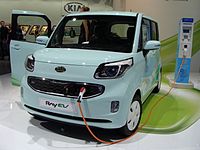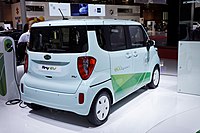Kia Ray
| Kia Ray | |
|---|---|
 | |
| Overview | |
| Manufacturer | Kia Corporation |
| Production | 2011–present |
| Assembly | South Korea: Seosan Plant, Seosan (Donghee) |
| Body and chassis | |
| Class | City car (A) |
| Body style | 5-door minivan |
| Layout | Front-engine, front-wheel-drive |
| Platform | Hyundai-Kia SA |
| Related | Kia Picanto (TA) |
| Powertrain | |
| Engine | |
| Electric motor | 50 kW (68 PS; 67 hp) (16.4 kWh) 64 kW (87 PS; 86 hp) (35.2 kWh) |
| Transmission | |
| Battery | 16.4 kWh lithium ion battery 35.2 kWh LFP battery |
| Range | 138 km (86 mi) (16.4 kWh) 205 km (127 mi) (35.2 kWh) |
| Dimensions | |
| Wheelbase | 2,520 mm (99.2 in) |
| Length | 3,595 mm (141.5 in) |
| Width | 1,595 mm (62.8 in) |
| Height | 1,700–1,710 mm (66.9–67.3 in) |
| Curb weight | 988–1,110 kg (2,178–2,447 lb) 1,290–1,295 kg (2,844–2,855 lb) (EV) |
The Kia Ray (Korean: 기아 레이) is a city car manufactured by Kia exclusively for the South Korean domestic market. Based on the Kia Picanto/Morning, it was specifically developed in compliance with the "light car" (Korean: 경차, romanized: Gyeongcha) category that offers tax incentives for cars with exterior dimensions below 3,600 mm (141.7 in) in length and below 1,600 mm (63.0 in) in width.[1] This is a Korean-only vehicle.
Overview
Only available in the local Korean domestic market, the Kia Ray is equipped with a 998 cc gasoline engine which generates 78 PS (57 kW; 77 hp) at 6,400 rpm.
The Ray has a unique door layout; the passenger side of the vehicle has a sliding door for the rear seats, while the driver's side has a swing-out door.[2] The car has a kei car-inspired boxy dimensions. The Ray's interior benefits from the square shape, as it has more space than most cars its size; however, it is only able to seat four people.
Kia Ray (2010 concept)
The Ray nameplate was used for an unrelated plug-in hybrid concept vehicle, based on the contemporary Kia Forte. It debuted at the Chicago Auto Show in February 2010[3] and subsequently was exhibited at Geneva.[4]
The plug-in hybrid concept Ray was equipped with a 1.4L GDI engine developing 114 kW (153 hp)[5] and a 78 kW (105 hp) electric traction motor which drew power from a lithium-ion polymer battery sufficient to give the vehicle a 80 km (50 mi) all-electric range.[3] The combined range was 1,200 km (750 mi) on a single tank of fuel, with an estimated consumption of 1.398 L/100 km (168.3 mpg‑US).[4]
Kia Ray EV (2011)
The Kia Ray EV was launched in 2011 as Kia's first production battery electric vehicle. It is powered by a 50 kW (67 hp) electric motor, with a 330 V, 16.4 kWh lithium ion battery that allows an all-electric range of 139 km (86 mi) depending on driving conditions.[6][needs update] The traction motor has a rated torque output of 167 N⋅m (123 lbf⋅ft).[7]
Despite a curb weight of 1,185 kg (2,612 lb),[8] an increase of 187 kg (412 lb) compared to the conventionally-powered model, the Kia Ray EV was claimed to accelerate from 0–100 km/h (0–62 mph) in 15.9 seconds and achieved a top speed of 130 km/h (81 mph).[7] Charging times ranged from 6 hours (using a 220 V AC household supply) to 25 minutes (using a DC fast charge station).[9] The AC charging port is in the front grille, while the DC charging port is where the fuel filler door is on the conventional model.[10]
The initial roll out was limited to a production run of 2,500 vehicles destined for the South Korean government fleets, and scheduled to be deployed in 2012.[7] In May 2013 a fleet of 184 Kia Ray EVs were deployed in Seoul as part of a carsharing service called "Electric Vehicle Sharing” at a rate of US$5 per hour. The service had 15,000 registered customers by May 2013.[11]
Production of the Kia Ray EV ended in 2018.[12] An updated Kia Ray EV was announced in August 2023 and launched on September 21, 2023; the updated vehicle features a bigger 35.2 kWh LFP battery and more powerful 64 kW (87 PS; 86 hp) electric motor.[13]
- Kia Ray EV (front)
- Kia Ray EV (rear)
- Right side featuring sliding rear door
2017 facelift
The New Ray, which received a facelift, was released on December 13, 2017.[14] The radiator grille in the centre of the existing model was raised to the same height as the headlamp and changed to body colour. Wide honeycomb patterns were also applied to tailgate garnish.
The sudden braking alarm system was applied to all trims, and rollover detection was added to the existing six airbags. It is designed to add four-point colours and license plate LED lamps to loops, outer mirror covers, and radiator grills from three popular body colours, Milky Beige, Clear White, and Aurora Black Pearls.
A single-seater Kia Ray Van was released on February 8, 2022. It operates with a total of two trims, Prestige and Prestige Special. Driver convenience specifications such as a driver's heating wire seat and a driver's seat height adjustment device are added to the Prestige Special.[14]
- Facelift (front)
- Facelift (rear)
2022 facelift
The New Kia Ray, which received a second facelift, was unveiled on August 10, 2022[15] and released on September 1. On the front, Starmap signature lighting and centre garnish are placed horizontally. The bumper has a flat, angular design. The skid plate was applied to the lower part of the bumper. A 15-inch alloy wheel with a geometric shape is applied to the side. On the rear, a rear combination lamp was applied, and Starmap signature lighting was placed on the edge of the rear combination lamp. In addition, an additional non-exposed tailgate handle was applied. A 4.2-inch LCD cluster design was applied to the interior, and a light gray interior was added.[16]
Driver assistance system and convenience features such as Rear Cross-Traffic Collision-Avoidance Assist, Safe Exit Warning, ventilated driver's seat, air-purification mode are also applied.
On November 17, 2022, Gravity, the design differentiation model of The New Kia Ray, was added. Gravity is based on Ray's top trim signature and applies new design elements to create a tough-looking exterior. The dark metal front centre garnish and rear tailgate garnish give a solid impression, and black colours are applied to the front and rear skid plates, A-pillars, roof, and exterior mirrors to create a sophisticated atmosphere. On the sides, 15-inch black alloy wheels are applied.
- Facelift (front) (South Korea)
- Facelift (rear) (South Korea)
Kia Ray EV (2023)
The updated Kia Ray EV launched on September 21, 2023,[17] with availability limited to South Korea.[13] Compared to the prior version which had been discontinued in 2018, the price was cut significantly from ₩45 million to ₩27.4 million, approximately ₩20 million after national and local incentives.[18] It follows the styling changes introduced for the 2022 update[19] and has a maximum range of 205 km (127 mi). Rated efficiency is 5.1 km/kWh (106.8 mpg‑e) in combined city/highway driving.[20]
It is equipped with an electric traction motor with a maximum output of 64.3 kW (86.2 hp) and 147 N⋅m (108 lbf⋅ft) of torque. The 265 V, 35.2 kW-hr LiFePO
4 battery is rated to replenish up to an 80% state of charge in 40 minutes using a 100 kW DC source;[20] on a household AC source, it recharges in six hours.[18] The charging port is in the front grille.[19]
Kia Ray sales have grown year-on-year since 2017; the 2023 increase was credited to the introduction of the updated EV model.[21] In the first quarter of 2024, the Kia Ray EV was the best-selling domestically-produced electric vehicle in South Korea, with 2,442 vehicles sold; for all electric vehicles sold in Korea, it was second overall behind the Tesla Model Y, which sold 6,012 during the same period.[22]
Sales
| Year | South Korea[23] |
|---|---|
| 2011 | 4,107 |
| 2012 | 43,891 |
| 2013 | 27,421 |
| 2014 | 30,113 |
| 2015 | 25,985 |
| 2016 | 19,819 |
| 2017 | 20,521 |
| 2018 | 27,021 |
| 2019 | 27,831 |
| 2020 | 28,530 |
| 2021 | 35,956 |
| 2022 | 44,566 |
| 2023 | 50,930 |
References
- ^ "기아 모닝 레이 | 쉐보레 스파크 2021 경차 혜택?". 프리카톡 (in Korean). 2021-01-08. Retrieved 2021-07-17.
- ^ Sarne, Vernon B. (2019-07-24). "The Kia Ray city car is nice, but can we really afford it?". Visor. Retrieved 2019-07-24.
- ^ a b Swan, Tony (February 10, 2010). "Kia Ray Plug-In Hybrid Concept". Car and Driver. Retrieved 1 July 2024.
- ^ a b Brogan, Matt (3 March 2010). "Kia Venga EV Concept, Kia Ray plug-in hybrid at Geneva 2010". Drive (Australia). Retrieved 1 July 2024.
- ^ Evans, Scott (February 7, 2010). "Kia Ray Concept". Motor Trend. Retrieved 1 July 2024.
- ^ "New Kia Ray is Korea's first production EV". Autoblog Green. 2011-12-22. Archived from the original on 2012-01-09. Retrieved 2012-01-06.
- ^ a b c "Kia Presents Korea's First Production Electric Model, the New Ray EV". CarScoops. December 22, 2011. Retrieved 1 July 2024.
- ^ "Geneva Motor Show 2012" (Press release). Kia Press. March 6, 2012. Retrieved 1 July 2024.
- ^ Ashe, Suzanne (December 22, 2011). "Kia Ray EV rolls into Seoul". CNET. Retrieved 1 July 2024.
- ^ "Kia introduces Ray EV in Korea; 2,500 units to be produced in 2012 for use by government agencies". Green Car Congress. 22 December 2011. Retrieved 1 July 2024.
- ^ Eric Loveday (2013-05-06). "South Korea Now Offers Electric Vehicle Rentals With Rollout of 184 Kia Ray EVs". InsideEVs.com. Retrieved 2013-06-07.
- ^ Bin, Nan-Sae (August 20, 2023). "Kia to revive Ray EV to kick start S.Korean city car market". The Korea Economic Daily. Retrieved 1 July 2024.
- ^ a b Mihalascu, Dan (August 23, 2023). "Cheaper Kia Ray EV Minicar Returns To Korea With More Range, Power". Inside EVs. Retrieved 27 June 2024.
- ^ a b "Korea's first one-seater light car VAN was born... "Surprise" at the price of Ray which disappeared in the passenger seat". 《The JoongAng》. Retrieved February 8, 2022.
- ^ "2023 Kia Ray Revealed With A Second Facelift In South Korea". motor1.com. Retrieved August 11, 2022.
- ^ "2023 Kia Ray EV Previews Its Second Facelift In South Korea". INSIDE EVs. Retrieved August 12, 2022.
- ^ Bae, Sungsu (September 21, 2023). "Kia releases EV model of compact car Ray". The Korea Economic Daily. Retrieved 27 June 2024.
- ^ a b Chea, Sarah (August 23, 2023). "Ray EV comes back with a half-price tag, doubles driving range". Korea JoongAng Daily. Retrieved 1 July 2024.
- ^ a b Pappas, Thanos (October 5, 2023). "Kia Ray EV Updated In Korea With More Power And Longer Range". CarScoops. Retrieved 27 June 2024.
- ^ a b "Ray (brochure)" (PDF). Kia Motor Company. May 1, 2024. Retrieved 27 June 2024.
- ^ Lee, Kevin (December 4, 2023). "Kia's Ray Achieves Record-Breaking Sales in 2023, Fueled by EV success and Growing Appeal Among Younger Buyers". The Korea Bizwire. Retrieved 1 July 2024.
- ^ 최기성 (April 22, 2024). "'싼맛'에 탔는데, 경차 따위가 3천만원?…"탈수록 돈 된다" 레이 EV 반전 [최기성의 허브車]" [I drove a 'cheap' compact that costs 30 million won? "The more you drive, the more money you save" Ray EV]. 매일경제 (in Korean). Retrieved 1 July 2024.
- ^ Kia. "Sales Results | IR Library | Kia Global Brand Site". Kia. Retrieved 2024-02-24.
External links
- Official website (in Korean)
- Official website (EV) (in Korean)







